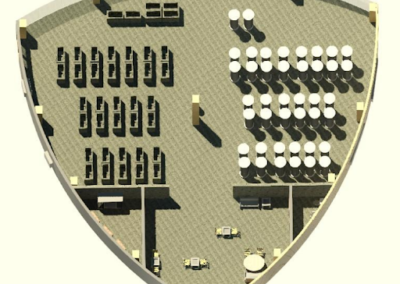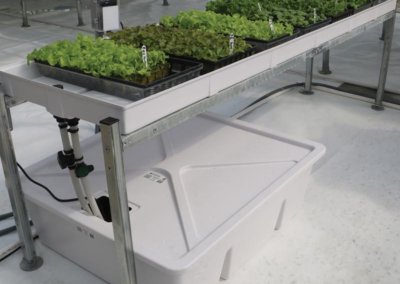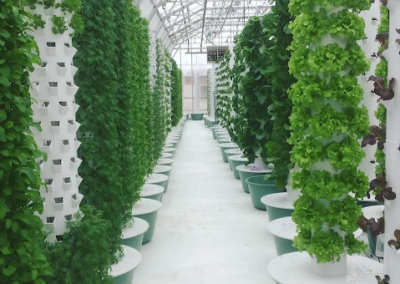Mines Greenhouse
Overview
University administration challenged Green Beings for Green Beans (GB4GB), one of several project teams within the Smart Environments Design Studio, to design a greenhouse for the Colorado School of Mines community. Design objectives were determined through stakeholder feedback and direction from university administration. These include creating an energy efficient growing environment that embodies the spirit of Mines and encourages community members to sustainably grow their own fresh produce. In addition, the greenhouse will promote mental health and wellness by integrating multi use space with growing areas. To best address this design challenge, three design sub-teams were formed: structural design, climate control, and cultivation/irrigation systems design. The sub-teams worked cooperatively to address the needs for each part of the greenhouse to ensure a cohesive final product.

Team Members
- Natalie Farmer
- Dinie Sukor
- Eli Webb
- Ethan Judy
- Jeremy Abraham
- Michelle Butler
- Phi Tran
- Reyno Mu
- Shannon Keohane
- Victoria Waters
The Client
- Senior Design Capstone
Acknowledgements
GB4GB would like to express our gratitude to Stephen Frank for his commentary and guidance through every step of this project. A special thanks to John Persichetti who always provided help and support since the beginning of the project. The team would like to thank Lauren Poole and the Senior Design Capstone for trusting our project design and funding our aeroponics system for demonstrative use in CTLM. Thank you to Chris Cocallas for providing advice from a professional viewpoint and considering our greenhouse design to be part of the Colorado School of Mines infrastructure. The team would also like to thank Alex Macmillan for providing a tour of the CU Boulder greenhouse. Having the opportunity to view a state of the art facility drove us to design an environment that will be a point of interest on our own campus.
In addition, the structural team would like to give special thanks to the Civil Department faculty for their guidance through calculations, analysis, and other design considerations.The climate control group would like to thank our former group member Sophie Vamvakias, Swapnil Kumar of Ceres Greenhouse Solutions and Andrew Parker from NREL. Also, thank you to the students and faculty of Colorado School of Mines for the support that has driven GB4GB to design the coolest greenhouse in Colorado!
Elevator Pitch
Design Approach
Initial ideas were gathered from the Mines community via an online survey that focused on space usage, interest in a campus greenhouse, and the types of produce people might like to grow. Feedback received was overwhelmingly positive and guided GB4GB towards designing a space that allowed for small scale food cultivation and student relaxation. Figures 1-3 below show the responses of over 100 survey participants. The goals associated with meeting the expectations of the stakeholders include designing a unique structure that represents the Mines community and continues to add to the appeal of campus, generating a cultivation/irrigation system that incorporates advanced technology while allowing any user to easily operate the system regardless of their background, and incorporating methods to achieve energy efficiency through climate control.
Structural Subteam
For the structural team, there were two main design criteria that we were concerned with: choosing a building material and designing a unique, interesting structure that would continue to add to the appeal of campus. Initially, the footprint of the building was selected to be rectangular, but as brainstorming progressed, the proposition of designing a structure to recreate the Mines logo, by shaping the building as a reuleaux triangle, was introduced. This idea was well received by students and administration because of its uniqueness and symbolism of Mines. By February of this year we had developed a design that the entire project team was excited to move forward with. We shifted our simple, rectangular design into a triangle with three main interior sections designated for planting, storage, and student space and a courtyard in the middle. The curvature of the Rouleaux shape would be captured through the roof which would be curved along the edges and corners to form vestibules at the end of each building (Figure 4).
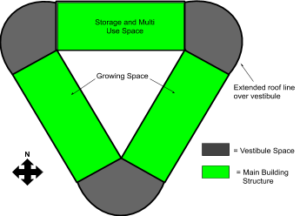
Figure 4. Preliminary floor plan for the reuleaux design
As we began sharing this design through our Intermediate Design Review and several meetings with individuals on campus, it was brought to our attention that to truly capture the Mines spirit and allow ourselves to produce the most space and energy efficient building, we would want to consider closing in the roof and adjusting the wall shape to more closely match the curvature. A substantial redesign was put into motion. The new, and most current, design is a fully enclosed reuleaux triangle, with curved outer walls and a sectioned off student space on the north side of the building (Figure 5).
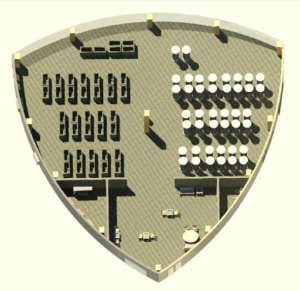
Figure 5. Current floor plan
Throughout the design process, load calculations were completed for each change in framing. Using calculated values, member analysis was done using structural analysis software, ForteWEB. Though hand calculations would be the most accurate for determining member sizes, they are very time consuming and have a high risk of math errors. During analysis, each member’s slope, length, and intermediate supports were input into Forte. Within each solution, check calculations were made for maximum shear, moment and deflection along each beam. The most frequent error to occur was extreme uplift on the roof beams that was caused by a vertical wind force. This caused members to need to be sized up and include hurricane ties at each support. Intermediate supports were added along each member to also counteract this reaction.
Cultivation Subteam
The cultivation and irrigation team used a design matrix to compare potential hydroponic systems and ultimately chose hydroponics. Hydroponics ranked the best for plant growth and production, minimizing water losses, ease of use and the ability for customization when compared to geoponics, misters, and drip systems. Hydroponics have the highest capital cost, however, they allows for low operating costs. In addition, hydroponics are innovative, unique, and create interest in gardening. The team toured the CU Boulder greenhouse to get inspiration for the hydroponic system design. After the tour, the team decided to pursue aeroponic tower and ebb and flow tray designs for the greenhouse.
The team used renderings to understand the dimensions of the towers and trays, which allowed for the optimization of the available space and amount of natural sunlight (Figure 6). In addition, the team researched and completed supplemental lighting needs for the greenhouse. Finally, a production yield calculation for each system was completed to verify that these systems will be able to meet the needs of the users.
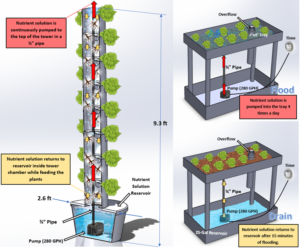
Figure 6: Model of growing tower and ebb and flow tray
Climate Control Subteam
The climate control team researched the fundamental processes in heat transfer in greenhouses, and the methods used for climate control greenhouse. The climate control team created a building energy model in OpenStudio to identify the heating and cooling needs of the greenhouse building envelope to inform the HVAC(Heating, Ventilation, and Cooling) sizing needs of the greenhouse. OpenStudio software does complex building energy calculations for a building with specific size, shape, construction materials, and operation goals. This model allowed the team to simulate and compare passive temperature control measures, and provided simulation data for engineering analysis of selected heating and cooling systems. Through passive measures the team reduced the estimated total annual building energy consumption by 48%.
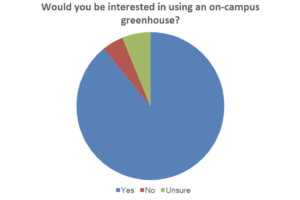
Figure 1: Initial outreach survey responses
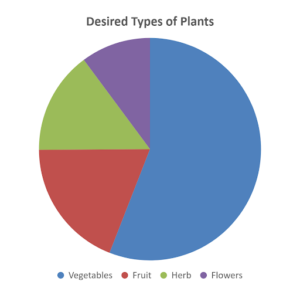
Figure 2: Initial outreach survey responses
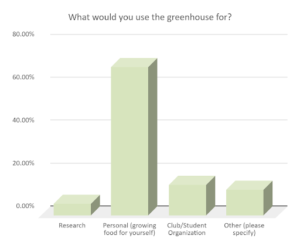
Figure 3: Initial outreach survey responses
Design Solution
Structural Subteam
In terms of the structural design, the chosen solution meets original intentions to be unique to Mines and provides a space for students to come and relax. Energy efficiency is reached through passive solar effects that are made possible with passive solar walls separating the growing space from the multi-use area (Figure 7). The finished greenhouse will provide a great resource for students that might be struggling to find healthy food choices and those that might need a space where they can relax on campus. Based on typical commercial construction costs of $200 per square foot as provided by University Architect Chris Cocallas, the estimated cost, at this time, is about $1.4 million dollars. This estimate only considers construction costs which includes prices for building materials, professional engineering fees, and contingency percentages.
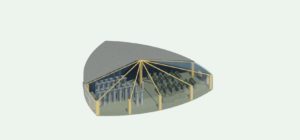
Figure 7. Final greenhouse design
Cultivation Subteam
On a rotating semesterly schedule, Mines students, faculty, and staff can reserve one of the 168 plots. A plot consists of half of an ebb and flow tray or half the height of an aeroponics tower. This solution allocates 50% of the greenhouse growing space to the aeroponics towers and 50% to ebb and flow trays. The aeroponic towers are positioned on the west side so that they maximize sun exposure by avoiding shading the trays (Figure 8). The tower systems are on wheels so users are able to rotate or temporarily move the towers for planting and harvesting if needed. Using this layout, there are 42 aeroponic towers and 42 trays.
The production yield was calculated for each system. Planting Green Ice lettuce throughout the forty-two ebb and flow hydroponics systems yields 9.828 bunches worth of loose-leaf lettuce every 45 day cycle. A single system can produce 234 bunches during a 45 day cycle and 1,170 bunches during a school year (i.e. two 16 week periods). Once again using the Green Ice lettuce variety with a 45 day time to harvest, the forty-two aeroponics systems would yield 1,848 bunches worth of loose-leaf lettuce per 45 day cycle. A single tower could produce 44 bunches during a 45 day cycle and 220 bunches during a school year. Similar calculations were completed using a Better Boy tomato variety. The team concluded that the number and type of hydroponic and aeroponic systems chosen would meet Mines community member production needs.
The plumbing system includes a water supply and drainage system with standard pipe diameter of 1 inch and 4 inches respectively. A 5.4 in. x 3.2 in. trench drain will also be installed (Figure 9). In order to meet the target DLI as discussed, the greenhouse requires 47 LED fixtures (Phytomax-2 600 LED made by Black Dog LED), placed 5 ft above the plants and spaced roughly 8 ft apart from every fixture (Figure 10). The total annual operating utilities cost for the greenhouse is approximately $8,864, where the annual water bill is $353, the annual electricity bill for all of the pumps is $1,452, and the annual electricity bill for the lights is $7,060.
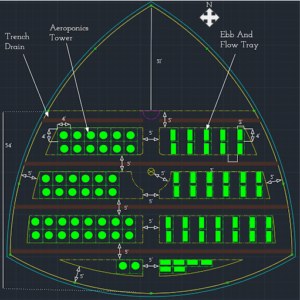
Figure 8: Tower and planter layout
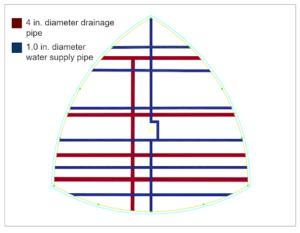
Figure 9: Plumbing layout
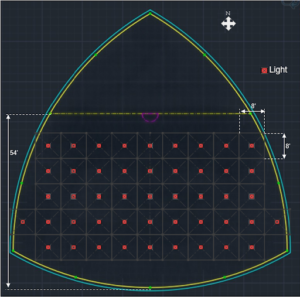
Figure 10: Artificial lighting layout
Table 1: Cultivation/irrigation system cost estimate
|
# |
Cultivation System Items |
Unit |
Unit Price |
Total Price |
|
1. |
42 |
$59.00 |
$2,478.00 |
|
|
2. |
42 |
$620.00 |
$26,040.00 |
|
|
3. |
72 |
$89.00 |
$6,408.00 |
|
|
4. |
42 |
$405.95 |
$17,049.90 |
|
|
5. |
294 |
$1.09 |
$320.46 |
|
|
6. |
294 |
$1.18 |
$346.92 |
|
|
7. |
47 |
$1,239.00 |
$58,233 |
|
|
Total |
$110,876.28 |
|||
Climate Control Subteam
The climate control team sought to maximize the effectiveness of the heating system while decreasing the total energy consumption and cost with its operation. The team selected a Ground to Air Heat Transfer (GAHT) system as well as a water-fed radiative pipe heating system for the heating control. The GAHT system uses the stable temperature of the soil as a heat source, pushing cold air from the greenhouse through a series of tubes underground, warming the air to be returned to the greenhouse. This system alone can meet the heating needs of the greenhouse 40% of the time. The rest of the heating will be accomplished by circulating hot water in a radiative pipe network fed by a tankless natural gas water heater. These components will have a fast response time through the convective GAHT system and thermal mass from the radiators. Greenhouse cooling will be accomplished with direct evaporative cooling with a pad and fad system. This system draws exterior dry air over a saturated pad, cooling the air just as it enters the greenhouse, and exhausts the air as it heats and the extra moisture from plant transpiration. The natural ventilation also reduces the cooling loads using shutters already present for the pad and exhaust fans as well as operable roof vents at the apex of the structure. The team performed calculations to confirm that the size and specifications of the systems chosen would meet the needs of the greenhouse climate control. The team selected the main commercially available components for the specified systems to estimate the material costs (Table 2).
Table 2: Climate Control Capital Cost Summary
|
System |
Component |
Component Cost $ |
|
Radiator Heating |
Piping |
551.36 |
|
Radiator Heating |
Pumps |
384.00 |
|
Radiator Heating |
Water heater |
680.00 |
|
GAHT |
Duct Fans |
530.00 |
|
GAHT |
Ducts |
72.38 |
|
GAHT |
Piping |
553.50 |
|
GAHT |
Manifolds |
605.00 |
|
Evap Cooling |
Pad Kit Package |
1915.00 |
|
Evap Cooling |
Louvers |
307.95 |
|
Evap Cooling |
Exhaust Fans |
639.00 |
|
Circulation |
Fans |
1002.00 |
|
Total Cost |
7240.19 |
Next Steps
Since the work of the design studio on this project is intended to proceed past the spring of 2020, the continuation of an EDNS491 group dedicated to the greenhouse will be required to see the project to completion. The process of transferring the project to students that will be in Capstone in the fall has already begun with the addition of one Senior Design 491 student this semester. By having this overlap between the spring and fall semesters, the transition period may be shortened due to the familiarity with the project.
Looking forward, the structural sub-group will likely shift focus towards site development once a final location has been designated for the greenhouse. This shift will require expertise in grading, drainage, utility layout and an overall understanding of site planning. Some reconsideration should also be given to the framing to ensure that intermediate supports for the beam do not interfere with the floor plan. Our team has prepared detailed structural drawings, calculations, and documentation of the project in order to provide the new project members with a strong understanding of the design concept and the progress made so far.
The cultivation/irrigation team has purchased one Tower Garden aeroponic tower for operational and demonstrative use. This tower will be built and implemented into the CTLM atrium during Fall 2020. The operational tower will encourage students to garden and create interest and support for this project. The next senior design team will create a maintenance plan and care for the tower until it is implemented into the greenhouse. Follow-up design tasks such as optimization of lighting design, detailed plumbing and lighting layout, hydroponics control systems and growing tests are also tasks the next team should focus on.
In addition, an operations manual describing how the greenhouse will work is in progress. This document will be an ongoing draft and will be passed onto the next team. The document will inform users about the purpose of the greenhouse, how to get involved with the greenhouse, how to reserve a plot, operational guidelines for each growing system, and safety guidelines. Future team members should continue editing this document so that it can be accessed once the greenhouse is constructed.
The climate control team performed some humidity calculations to determine estimated crop transpiration, however more extensive modeling of the vapor balance of the greenhouse will be needed to identify the precise dehumidification needs. Further exploration of some potential energy efficiency measures by future teams could be done either as modeling and calculation efforts or potentially as experiments in a built greenhouse. Some measures for climate control include:
- Liquid desiccants for humidity control
- Phase change material for additional passive energy storage
- Compost heat exchangers for hot water supply
- Solar water heating for hot water supply
- On site solar PV for electricity
The climate control team has done much of the analysis and calculations for the greenhouse HVAC system, however further validation of the control system logic sequence in conjunction with the specified HVAC systems will be necessary to ensure that the controls selected will achieve the desired growing conditions in the greenhouse. Additionally, the climate control team has not designed the actual controller hardware, electronic components, or control algorithms for use in the greenhouse, which will be necessary to ensure the highest yield possible.
Meet the Team
Natalie Farmer

Civil Engineering, May 2020
Dinie Sukor

Mechanical Engineering, May 2020
Eli Webb

Mechanical Engineering, May 2020
Minor in Electrical Engineering.
Ethan Judy

Electrical Engineering, May 2020
Jeremy Abraham
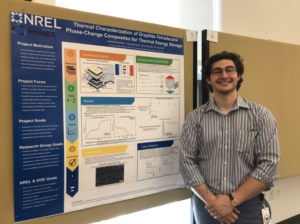
Mechanical Engineering, May 2020
Minor in Energy.
Michelle Butler
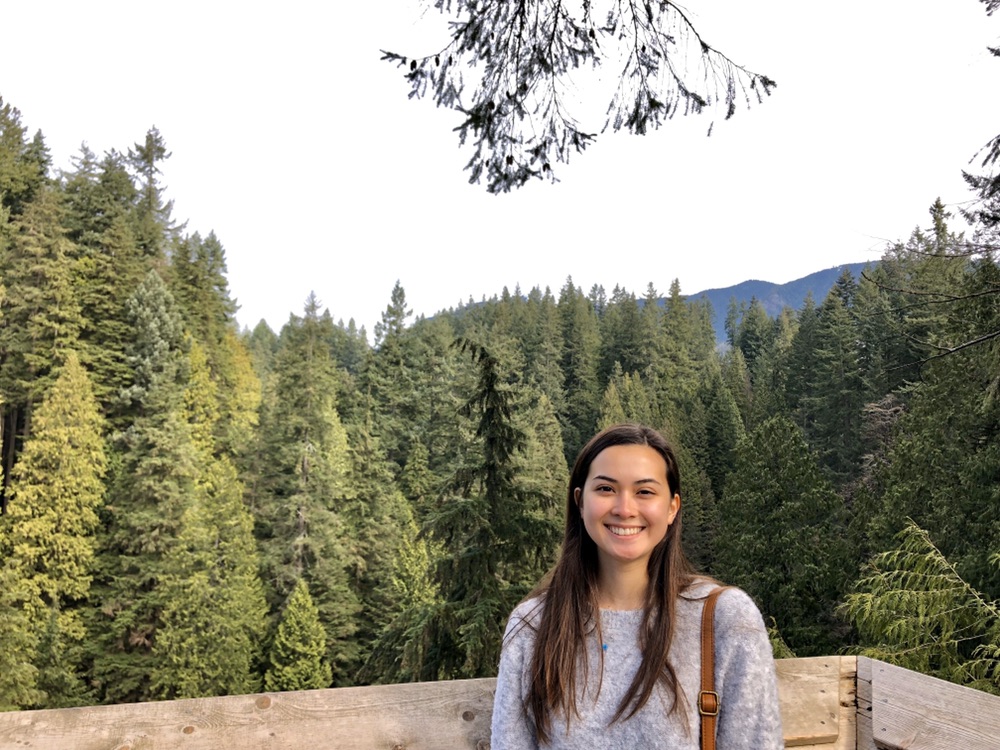
Mechanical Engineering, May 2020
Phi Tran

Mechanical Engineering, May 2020
Reyno Mu

Civil Engineering, May 2020
Shannon Keohane
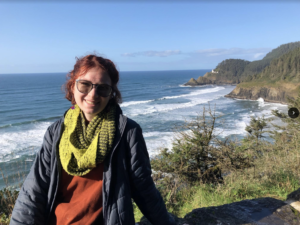
Environmental Engineering, May 2021
Minor in Public Affairs through the McBride Honors Program.
Victoria Waters

Civil Engineering, May 2020
